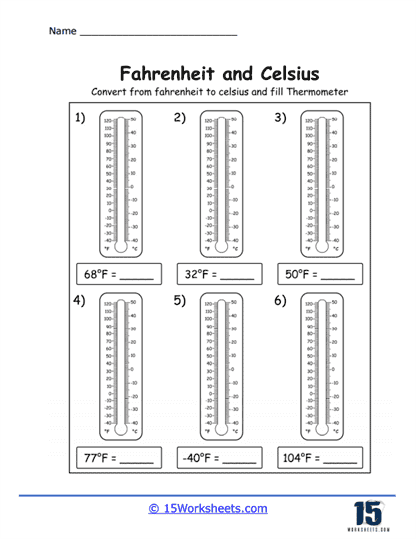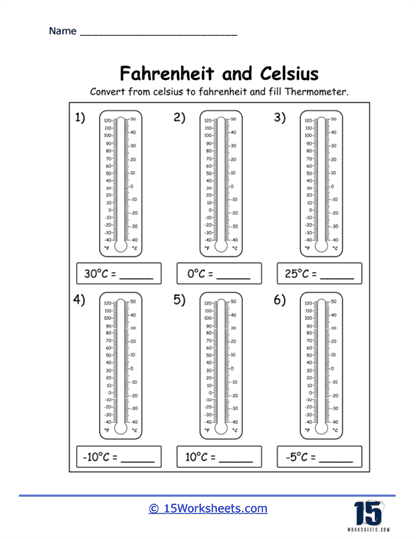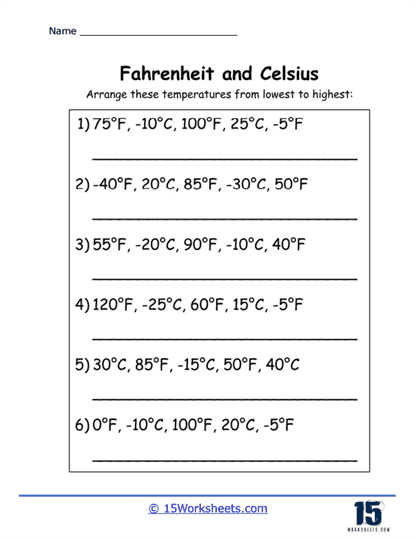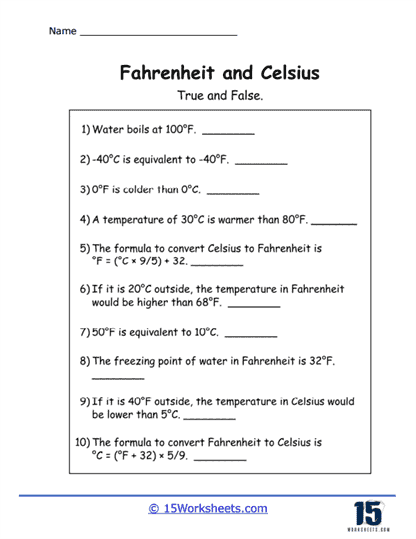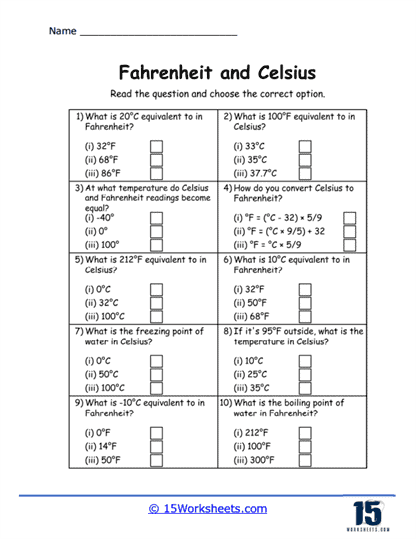Fahrenheit & Celsius Worksheets
About These 15 Worksheets
These worksheets teach students about temperature scales, specifically the Fahrenheit and Celsius scales. These worksheets are essential tools used in various educational settings, including elementary and secondary schools, and in contexts such as science and geography classes. The goal of these worksheets is not only to teach students how to read temperatures in these two scales but also to enable them to perform conversions between them and understand their applications in the real world.
The primary purpose of these worksheets is to enhance students’ understanding of and proficiency with the Fahrenheit and Celsius temperature scales. Fahrenheit, used mainly in the United States, and Celsius, used in most other parts of the world, are critical for describing temperatures in weather forecasts, cooking, science experiments, and many other practical situations. By working through these worksheets, students learn how to interpret and convert temperatures, which is a fundamental skill in scientific literacy.
Types of Exercises
1. Conversion Crusaders
Think of Chill and Grill, Conversion Marathon, Temperature Translator, and Degrees of Change as your intrepid temperature-converting heroes. Students dive into number puzzles like culinary daredevils-“If the oven’s at 350°F, what’s that in °C?”-or embark on full marathon brain workouts, converting long lists of temperatures under time constraints. In Temperature Translator, kids become polyglots of thermometry: “I’ll take 40 °C, s’il’vous plaît,” they’ll say, fluent in both scales. Degrees of Change shows them the math side, calculating how much temperatures rise or fall, sharpening their subtract‑and‑multiply chops.
2. Thermometer Tinkering & Graph‑y Fun
Thermometer Challenge, Thermal Ladder, Temperature Twist, and Celsius Climb bring hands‑on, visual flair. In Thermometer Challenge, students sketch and label mercury bars, honing spatial‑number sense-and maybe dreaming of tiny thermometers growing in their stomachs. Thermal Ladder adds a vertical twist: each rung shows a new temp, and kids must compute or estimate the difference, like Indiana Jones navigating a ladder of heat. Temperature Twist throws in tricks-think “what if this reading were in kelvins?”-forcing mental acrobatics. Finally, Celsius Climb feels like scaling Everest: students start near freezing at the bottom of the page and inch upward, mastering °C increments and visual patterns as they ascend.
3. Word‑Problem Wizards & Storytelling
Made for budding novelists (and algebra lovers), Temperature Tales, Numerical Weather Report, Degrees of Difference, and Cool to Hot Truths set math within stories. In Temperature Tales, a sunbathing iguana or an Antarctic penguin narrates temperatures in confusing units-kids untangle the tale to solve the problem. Numerical Weather Report has students report daily highs and lows in both scales-complete with catchy headlines (“Blizzard Blows or Barbecue Breezes?”)-while Degrees of Difference might appear here again, since many word problems anchor on “How many degrees did it change?” Cool to Hot Truths ups the philosophical quotient: “If life feels like -10 °C and then whips to 30 °C, what’s changed? How do we cope?” (Math included.)
4. Competitive Conversions & Showdowns
No learning journey is complete without a little friendly rivalry. Temperature Showdown, Freeze & Fry, and Temperature Twisters are the collection’s gladiatorial pit. In Temperature Showdown, two fictional weather stations duel with thermometer readings-students must quickly convert and crown the victor. Freeze & Fry delivers comedic contrast: “Will Aunt Sally’s ice cream freeze at -20 °F or melt into soup?” Students analyze extreme temps to predict outcomes. And in Temperature Twisters, unexpected conversion challenges twist answers like tornadoes-four‑pack of crazily mixed units begging for sharp arithmetic.
5. Real‑World Remix & Reflective Reasoning
Rounding out the collection, Degrees of Difference (again!) and Numerical Weather Report (again!) step into deeper waters of reasoning and reflection. Students don meteorologist hats and analyze real‑life weather patterns-how did January compare to July? What does a 20° swing feel like? They write short reflections on why knowing both scales matters (“Why I’ll never argue about Celsius again when traveling in Europe!”). These worksheets aren’t just about correct answers-they invite students to think about comfort, culture, cooking, and travel through the lens of temperature.
When Do We Convert Between Fahrenheit & Celsius?
Celsius to Fahrenheit Formula – (°C x 9/5) + 32 = °F
The Celsius to Fahrenheit formula is used to convert temperatures from the metric system to the imperial system, which is commonly used in the United States.
It works by first scaling the Celsius temperature to match the size of Fahrenheit degrees-since Fahrenheit degrees are smaller, you multiply the Celsius value by 9/5 (or 1.8). Then, you add 32 to account for the fact that 0°C is equal to 32°F-this shift aligns the two scales at the freezing point of water. So, if you know the temperature in Celsius, this formula lets you accurately convert it to its Fahrenheit equivalent.
Fahrenheit to Celsius Formula – (°F – 32) × 5/9 = °C
The Fahrenheit to Celsius formula is used to convert temperatures from the Fahrenheit scale, commonly used in the U.S., to the Celsius scale, which is used in most other countries and scientific contexts.
This works by first subtracting 32 from the Fahrenheit temperature to remove the offset that accounts for the freezing point of water on the Fahrenheit scale. Then, you multiply the result by 5/9 to adjust for the difference in the size of the degrees between the two scales-Fahrenheit degrees are smaller, so you scale down to match Celsius. This formula helps you translate any temperature in Fahrenheit into its accurate Celsius equivalent.











